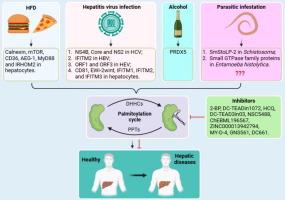肝脏疾病中的蛋白棕榈酰化:功能见解和治疗策略
IF 13
1区 综合性期刊
Q1 MULTIDISCIPLINARY SCIENCES
引用次数: 0
摘要
肝脏病理包括一系列疾病,从脂肪肝到侵袭性肝细胞癌(HCC),以及寄生虫感染,这些疾病共同构成了重大的全球健康挑战。s -棕榈酰化(通常称为棕榈酰化)是一种翻译后修饰(PTM),其特征是16碳棕榈酸(PA)链与靶蛋白上特定半胱氨酸残基的共价连接,在多种细胞功能中起关键作用,与肝脏的生理和病理状态密切相关。本研究旨在阐明蛋白棕榈酰化如何影响肝脏疾病的病理生理,并评估其作为诊断和治疗干预靶点的潜力。最近的研究已经确定了蛋白棕榈酰化在调节肝脏疾病的发生和进展中的关键作用。本文综述了蛋白棕榈酰化调节肝脏疾病病理生理过程的复杂机制,并探讨了靶向蛋白棕榈酰化修饰或调节该修饰的酶作为前瞻性诊断生物标志物和治疗靶点的潜力。本文章由计算机程序翻译,如有差异,请以英文原文为准。


Protein palmitoylation in hepatic diseases: Functional insights and therapeutic strategies
Background
Liver pathologies represent a spectrum of conditions ranging from fatty liver to the aggressive hepatocellular carcinoma (HCC), as well as parasitic infections, which collectively pose substantial global health challenges. S-palmitoylation (commonly referred to as palmitoylation), a post-translational modification (PTM) characterized by the covalent linkage of a 16-carbon palmitic acid (PA) chain to specific cysteine residues on target proteins, plays a pivotal role in diverse cellular functions and is intimately associated with the liver’s physiological and pathological states.
Aim of review
This study aims to elucidate how protein palmitoylation affects liver disease pathophysiology and evaluates its potential as a target for diagnostic and therapeutic interventions.
Key scientific concepts of review
Recent studies have identified the key role of protein palmitoylation in regulating the development and progression of liver diseases. This review summarizes the intricate mechanisms by which protein palmitoylation modulates the pathophysiological processes of liver diseases and explores the potential of targeting protein palmitoylation modifications or the enzymes regulating this modification as prospective diagnostic biomarkers and therapeutic targets.
求助全文
通过发布文献求助,成功后即可免费获取论文全文。
去求助
来源期刊

Journal of Advanced Research
Multidisciplinary-Multidisciplinary
CiteScore
21.60
自引率
0.90%
发文量
280
审稿时长
12 weeks
期刊介绍:
Journal of Advanced Research (J. Adv. Res.) is an applied/natural sciences, peer-reviewed journal that focuses on interdisciplinary research. The journal aims to contribute to applied research and knowledge worldwide through the publication of original and high-quality research articles in the fields of Medicine, Pharmaceutical Sciences, Dentistry, Physical Therapy, Veterinary Medicine, and Basic and Biological Sciences.
The following abstracting and indexing services cover the Journal of Advanced Research: PubMed/Medline, Essential Science Indicators, Web of Science, Scopus, PubMed Central, PubMed, Science Citation Index Expanded, Directory of Open Access Journals (DOAJ), and INSPEC.
 求助内容:
求助内容: 应助结果提醒方式:
应助结果提醒方式:


